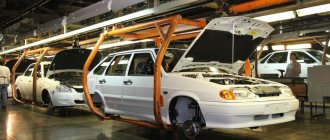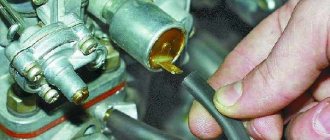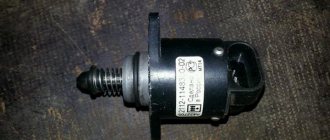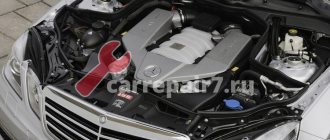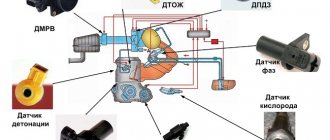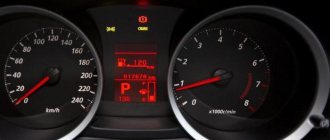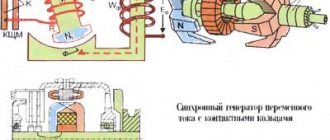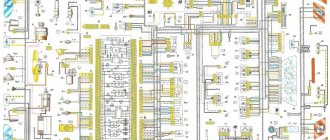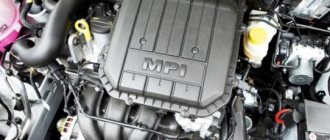Many owners of “fourteeners” are faced with a problem when, after 3-5 minutes of warming up a cold car, the VAZ 2114 stalls, then starts, but at 1-2 speeds the speed jumps strongly, which is why the car starts to twitch.
Subsequent “symptoms” may vary, so the car may work well in higher gears or stall in them, the check may be on or not, but all these problems belong to the same group and are associated with unstable engine operation. Therefore, below we will talk about possible causes and methods of diagnosing them.
How to find the cause of the problem
If the speed of the VAZ 2114 drops, you need to comprehensively diagnose the functioning of the injection system on your car, which can be done in your garage if you have a little experience and appropriate instructions. In this case, those “fourteeners” that were equipped from the factory with a dashboard from the German manufacturer VDO have an important advantage, since it, in comparison with the analogue from Schetmash, is equipped with a self-diagnosis mode.
To carry out this procedure, you will need to perform a few simple steps:
- After turning off the engine, you need to keep the odometer button pressed for three to five seconds;
- Having turned the engine ignition to the first position, the button must be released;
- arrows should appear on the display, which is a signal of normal operation, then the button must be pressed the first time (displaying the firmware version) and the second time - after this probable errors in the ECU will be shown;
- To reset the error message, you will need to hold the button until a zero appears on the display.
After reading the manual, you can find out what errors shown on the screen may be associated with the fact that the speed constantly drops when the gas is released on the VAZ 2114.
So, it could be one of the following situations:
- code 1 – controller error;
- code 14/15 – coolant sensor error;
- code 22/23 – throttle position sensor error;
- code 33/34 – mass air flow sensor error;
- code 42 – faulty ignition;
- code 44 – fuel mixture is lean or too rich.
To be completely sure, you will either need to take the car to a service center and pay for its inspection, or buy a diagnostic scanner yourself, which is not that expensive. Another option is if you have the same VAZ model (fully operational), one by one, remove it from it and install potentially vulnerable sensors on your car, using the method of elimination to find the problem.
Sensor malfunction
The normal functioning of the injection engine on the VAZ 2114 is ensured by the correct operation of four key sensors: throttle position, mass air flow, crankshaft position and coolant temperature.
The first of them - TPS - is responsible for the amount of gasoline supplied to the engine from the gas tank, and in some cases it can become clogged to the extent that the performance of its moving parts deteriorates. This breakdown is characterized by the engine stalling when changing gears - both when the gas is released and when the engine speed is reduced, if the damper does not open or close in time.
A faulty mass air flow sensor is more likely to lead to sharp drops in power and increased gas mileage, rather than to a stalled engine if it transmits incorrect incoming air readings to the ECU. This, in turn, leads to a leaner mixture supplied to the cylinders, which sometimes causes a drop in speed.
As for the DTOZH, when it fails, usually the car stalls already on a warm engine due to distorted information from the sensor, while a faulty DPKV is a very rare situation in which the fuel injection phases are disrupted and the engine begins to throttle severely.
OPTIONS FOR TROUBLESHOOTING
It is clear that if any emergency situations arise with the motor, it is advisable to contact a specialized service. However, this procedure is not always possible. Therefore, it is worth knowing how to independently diagnose the main systems and key parts.
THROTTLE VALVE AND ASSEMBLY
When the speed drops at idle and the car stalls, you need to pay close attention to the details of the throttle assembly. Long-term operation of the car on low-quality fuel and untimely maintenance of the air filter can lead to malfunctions of the throttle valve. It periodically jams if debris gets into the equipment
It periodically jams if debris gets into the equipment.
Throttle valve VAZ 2112
The problem can be solved by cleaning the system. The throttle is cleaned using carburetor cleaners. Using a compressor, you need to blow out the damper under the pressure of compressed air. It is not recommended to touch the screws located inside and on the side. If cleaning does not correct the situation, the device must be replaced. This operation is not particularly difficult.
CRANKCASE FAILURE
There is an oil trap in the crankcase ventilation system of the engine. Its contamination can also lead to interruptions in engine operation. Crankcase gases do not allow the engine to function normally, the speed fluctuates, the internal combustion engine stalls.
SENSORS
If a gasoline car stalls at idle, then one of the sensors is likely to break. In injection cars with an electronic engine control system, the engine usually starts normally, but then it stops working. It's worth checking here:
- Electronic car indicators;
- DRХХ – device that regulates idle speed;
- Air flow meter (air intake in the carburetor);
- Sensor indicating the position of the throttle curtain.
Electronic control unit in VAZ 2114
Interruptions in the operation of any sensors immediately affect the behavior of the electronics - errors appear in the car control unit. The “brains” of the machine receive unreliable information. It is not transmitted correctly to the engine. It starts working with parameters that do not correspond to reality. Self-testing of this device is not possible. You need to contact a professional for service.
Diagnostics of mass air flow sensor
The idle air control device is usually to blame for engine malfunction when the car idles poorly. But you pressed the gas pedal and the engine started. In the latest VAZ modifications, error information appears on the instrument panel.
When diagnosing, you must use a multimeter. If a part is faulty, it is recommended to replace it with a new one. All sensors are reasonably priced. It is better to start checking with parts that have a simpler design. Then gradually move on to complex devices. We must not forget that the problem may lie not only in the sensors themselves. It is also necessary to check the wiring to them and the presence of stable contact.
CARBURETOR
If the VAZ carburetor stalls at idle speed, then the jets may become clogged. Low-quality gasoline, deposits from the gas tank, contain small particles of debris. They can easily disrupt the operation of the fuel injection system. It is worth replacing the filter in front of the carburetor and cleaning the device itself. The dispensing part is cleaned using a cleaning solvent, which is sold in aerosol cans. Another reason is often a prolonged lack of carburetor adjustment.
In a mechanical fuel pump of carburetor cars, the filter mesh may be clogged with dirt. This reduces the performance of the device. Wear of the membrane and its destruction often leads to clogged carburetor channels.
INJECTOR
A situation that often arises is that various Lada models, as well as the VAZ 2110 injector stalls at idle. It is necessary to check the fuel pump strainer for clogging. This is a common problem with injection machines. It is better to immediately replace the part with a working one.
FILTERS PROBLEM
If the VAZ 2112 stalls at idle, then the fuel filter may be dirty. This also applies to other models of the concern. Generally, it is not practical to clean it. The part must be replaced. The same should be done with a dirty air filter. Low throughput leads to the fact that the air-fuel mixture simply floods the spark plugs.
Self-checking will not always lead to a positive result. It is often more practical to identify the cause of unstable operation of the internal combustion engine at a car service center. It will cost more, but specialized diagnostics will prevent more serious damage to the car.
What do drivers recommend?
In addition to the basic rules for operating a car, while driving and repairing their car, each driver gains additional knowledge and experience. Such nuances are learned as a result of mistakes made by the owner of the vehicle. Drivers share their experiences with each other, so you should also listen to the recommendations of car enthusiasts.
All drivers claim that it is prohibited to disconnect the terminals from the battery, especially from the injectors. A low charge level has a bad effect on starting the engine. You should not disconnect the mass for a long time in modern cars. The electrical unit that controls the engine may delete all data due to a lack of power.
It is not recommended to use the charging-starting device frequently, since it produces too strong current fluctuations, which sometimes leads to the unit burning out.
From the above, it becomes clear that there are many reasons why a car may not start. Even an experienced car mechanic is unable to determine the breakdown immediately. Therefore, if you feel that you cannot cope on your own, feel free to contact a service station. If you still decide to figure it out on your own, then inspect every centimeter of your car. Step by step you will discover the true source of the problem.
The operation of the injection system has always been a weak point of VAZ cars. Low-quality gasoline, counterfeit consumables, inept repairs done by yourself or unprofessional service - the car stalls for any of these reasons.
On older cars of the Samara-1 generation, a similar problem was solved by adjusting the carburetor and ignition. Less commonly, replacing the fuel pump. The electronic injector of the VAZ 2114 is many times more reliable than a carburetor; it starts and works in any weather without causing any trouble.
But if the injection machine still stalls, there can be many reasons for this.
Checking the ignition system
In some cases, the car starts to jerk due to some kind of malfunction in the ignition system. As a rule, the problem can be caused by untimely ignition of the fuel mixture. In rare cases, this is due to a weak spark from the spark plug, which in turn is due to low voltage supplied.
You will be interested in: “Honda Insight Hybrid”: technical specifications, photos and reviews from owners
Why does the VAZ-2114 jerk when driving? To do this, during diagnostics it is necessary to check:
First of all, the performance of the ignition coil. Serviceability of spark plugs (it is worth noting that if these elements malfunction, they are replaced as a complete set!). Pay attention to the condition of high-voltage wires. Are there any problems with the distributor (ignition distributor). Condition of the camshaft and crankshaft sensors.
And if the problem is the spark plug, then this is a fairly common and mild case. This type of breakdown is harmless and even a beginner can cope with it. Sometimes the problem may be caused by an incorrect gap between the spark plug contacts, which does not meet established standards.
But if the camshaft position sensor is to blame, then you won’t be able to start the engine at all. In this case, qualified assistance from specialists is necessary.
Air filter
If all the reasons described above do not apply, then you should pay attention to the filtration system. This unit also often leads to malfunctions.
On injection-type cars, filters are adjusted to an optimal and universal operating mode. This element is necessary in order to trap dust and dirt, but not impede the passage of clean air. Typically, small panel filters are installed in VAZs. They are considered more efficient and compact. However, cylindrical models are often installed in cars, which quite quickly cease to perform the task correctly. In this case, you will need a simple diagnosis of the VAZ 2114 car and replacement of the damaged element.
The car stalls when the clutch is depressed: do-it-yourself repair
As a rule, some of the problems associated with a stalling engine can be solved independently in a regular garage. The owner of many cars can clean the throttle himself, replace the fuel pump, filters, spark plugs, high-voltage spark plug wires, ECM sensors, etc.
Let's look at the most common operations in relation to gasoline cars. These include replacing the idle speed sensor or IAC (idle speed control). Note that on different cars the installation location of these elements may differ, but the replacement itself is almost identical.
The first step is to remove the terminals from the battery. Next, it is determined where the XX sensor is located. Then a chip with wires snaps off from it, which is secured with a latch. Next, unscrew the screws securing the regulator from the throttle pipe, after which the element is removed. Now the new sensor is put in place
During installation, it is important to ensure that the rubber sealing elements on the sensor (if any) fit tightly to the surfaces. Now the sensor, after installation and connection, needs to be calibrated. To do this, you need to put the terminals on the battery and turn on the ignition for 5-15 seconds
Then the ignition is turned off, after which you can test run the internal combustion engine.
As you can see, no difficulties arise if you need to replace the IAC. The process of cleaning the throttle valve is somewhat more complicated. To complete the task, you first need to purchase a special cleaner (carburetor cleaning liquid is suitable). Next, the throttle assembly is removed (in order to remove the element, separately study the repair manual for a specific car).
After dismantling the unit, use a cleaning fluid to wash the throttle valve and channels
Please note that you also need to blow out the crankcase ventilation channel (this can be done using a compressor by supplying air under pressure into the channel)
Also, during the process of removing the throttle, you need to carefully inspect the rubber seals of this unit. If the gasket is damaged, deformations, cracks, tears and other defects are noticeable, then the element needs to be replaced.
The throttle position sensor may also need replacement. To replace the TPS, you need to find this element (often it is located on the throttle pipe). The sensor is attached with ordinary screws that can be unscrewed with a screwdriver.
After this, a new sensor is installed in place. Typically, replacing the TPS solves the problem when the car stalls when you press the clutch, when braking the engine, or when you press the brake pedal.
As for fuel air filters, they also need to be inspected and changed if necessary. Replacing the air filter is not difficult, since you just need to unscrew the cover of the filter housing, remove the old filter element and install a new one. The main thing is to choose the correct size air filter and place it sideways.
When it comes to the fuel filter, you should first locate the fuel pump fuse in the fuse box and turn it off. Then you will need to start the engine. As a result, the fuel pump will not work, the pressure in the power system will drop and the internal combustion engine will soon stall.
Next, you need to find a fuel filter (on different cars it is installed in the engine compartment, in the lower part of the car outside on the bottom, in the area of the gas tank, etc. Often the filter is attached with steel clamps, screwed with screws, etc. Fuel filters are also attached to the filter housing pipes that are removable. Keep in mind that gasoline may leak out of the filter when removed.
When installing a new filter, there should be arrows on the housing that indicate how to correctly position the filter element. The arrows should show the direction of fuel movement from the fuel tank to the engine.
After installing the filter and tightening all the fasteners, turn on the fuel pump by reinstalling the fuse, then you can turn on the ignition for 3-5 seconds so that the fuel pump raises the pressure in the system. After this, the engine can be started.
When the engine is running, you need to again inspect the installation location of the fuel filter. No fuel leaks are allowed at the connection point of the fuel pipes or along the filter housing.
"Women's" reasons
This conditional category includes reasons that sometimes arise for people who are inattentive or do not service their car in a timely manner.
These include:
- Buying fuel at “left-handed” gas stations – this category also includes the purchase of cheap “grades” with various additives disguised under the names “E”, “ER” and others. It is not profitable for large chain gas stations to deceive customers, because selling normal fuel is cheaper than giving bribes to everyone, especially when it comes to the scale of the country, but the legislator does not prohibit selling some 95Er, with the alcohol content honestly indicated in the specifications. All drivers know about this, but greed takes over and such fuel kills the engine over time. The same situation has developed around “cheap underground” gas stations selling fuel siphoned off from truckers or military personnel.
- Dirty fuel and air filters - a symptom of this problem is when the VAZ 2114 stalls while driving or when you press the fuel pedal. Both filters are involved in the process of forming the fuel mixture, therefore, when the fuel one breaks, the gasoline supply is unstable, and if the air filter is used, the mixture becomes over-enriched, which in both cases leads to flooding of the spark plugs.
- Spark plugs - this car part can fail not only due to the reasons described above, but also due to age and improper care. Experienced car enthusiasts check spark plugs in VAZ cars at least once a month. To do this, you need to unscrew it with a spark plug wrench and evaluate the carbon deposits - the working spark plug has a light gray electrode and a light brownish carbon deposit. If the color is different, it's time to purchase a new set.
- Lack of fuel - everyone knows that it is better to drive on a full tank, but domestic motorists, due to the constant lack of money, the eternal crisis in the country and other similar reasons, prefer to drive on an almost empty tank and refuel only when absolutely necessary. At the same time, the accuracy of FLS on domestic cars is far from ideal and VAZ is no exception. Therefore, stopping at an angle, driving until the car stalls, topping up the tank on the road from a canister have a very negative effect on the fuel system, debris gets into it, and fuel is constantly supplied along with air.
- “Left” service stations - the saying “the miser pays twice” is most relevant when it comes to cars. Garage services, repairs from friends and other attempts to save money often turn into the fact that your VAZ 2114 injector does not idle, there are engine problems, and repairs need to be carried out at an official service center.
Why does the VAZ 2114 stall while driving? Main causes and repair instructions
Often, owners of “fourteeners” have a problem - the VAZ 2114 stalls while driving, in this article we will look at the possible causes and methods of solving this unpleasant phenomenon. First, let’s look at why the engine of a VAZ 2114 engine can stall while driving, even at idle speed:
- A common cause of unstable engine operation is the idle speed sensor (regulator). It's easy to check its operation. The engine does not start when you start it at idle, but it starts when you add gas. At the same time, when the car is running, the speed fluctuates, as soon as you take your foot off the pedal; The conclusion is obvious - replace the idle air control.
- Another reason for unstable engine idling may be a clogged throttle valve. In most cases, simply cleaning it is enough. However, it is recommended to clean not simply by pouring liquid and gassing. It is better to remove it, wash it thoroughly and blow it out with a compressor. The screws inside the throttle valve and on the side must not be touched;
- If cleaning does not help, it is most likely to assume a failure of the throttle position sensor (TPS). Replacing it is very simple and does not require contacting a car service.
The VAZ 2114 stalls while driving most often for the following reasons:
- First of all, motorists are guilty of using low-quality fuel, so it is logical to start looking for the reason for the engine stopping. You will be very lucky if the malfunction appears immediately after the next refueling; in this case, you can drain the gasoline and change the fuel filter with complete confidence;
- If the problem is not gasoline, the spark plugs are the next to come under suspicion. For an experienced driver, the condition and color of the spark plugs can tell almost everything about the operation of the engine. It is very easy to determine their performance by eye. In its working condition, the spark plug has a gray-brown soot and a light gray central electrode. If the color is different, the candles should be replaced;
- An excessively dirty fuel filter causes unstable fuel delivery. In fact, when you add gas, the engine stalls. There is only one way out - replacing the filter;
- The situation is similar with the air filter. In case of severe pollution, no air is supplied, therefore the air-fuel mixture enters the combustion chambers, over-enriched, and the spark plugs are flooded. The solution is the same - replacing the air filter;
- One of the most common problems with fuel-injected cars is clogging of the fuel pump mesh. The hatch is located under the rear passenger seat; often it is enough to replace this mesh with a new one;
- Interruptions in engine operation or stopping for no apparent reason may also be a consequence of a faulty ignition module. To repair it on your own, you need to know at least the minimum basics of electrical engineering;
- Also, one of the reasons for a sudden engine stop may be a generator malfunction. When it breaks down, the voltage on the on-board network drops, the car is powered only by the battery. A generator malfunction can be easily determined by a decrease in network voltage on the instrument panel. See the article “How to check the generator on a car without removing it”;
- A malfunction of the mass air flow sensor (MAF) can cause the engine to stop randomly. This sensor is installed in the pipe connecting the throttle valve and the air filter. Usually, if it breaks down, the CHECK ENGINE indicator on the dashboard lights up.
You can determine its malfunction not only using computer engine diagnostics, but also yourself. To do this, turn off the mass air flow sensor by disconnecting the connector and start the engine. Thus, the controller will go into emergency mode, and the supply of the air-fuel mixture is regulated only by the throttle valve, the idle speed exceeds 15,000. Here we recommend the article “How to adjust idle speed.” Based on the results of a test drive, you can draw a conclusion about the condition of the sensor. In principle, these are all the basic tips, and if the engine on the VAZ 2114 continues to stall, then it’s time to get to the nearest service station. AutoFlit.ru
- The door of the VAZ 2114 does not close
- The torpedo burst in winter VAZ 2115 reasons
- How to attach a torpedo to a VAZ 2110
- VAZ 2114 torpedo painting
- How to paint a VAZ 2114 torpedo
- VAZ 2114 trim for VAZ torpedo
- Which torpedo is suitable from a foreign car for a VAZ 2110
- How to remove a torpedo on a VAZ 2114
- Torpedo VAZ 2110 description of buttons photo
- Why does antifreeze knock out from the expansion tank on a VAZ 2115?
- Why is antifreeze thrown out through the expansion tank of a VAZ 2114?
We diagnose by eye and ear
The quality of such diagnostics greatly depends on the experience of the car enthusiast; a Soviet school driver simply learns more about the car by sound than some specialists can by conducting computer diagnostics. Even if you are not a professional, you need to find the answer to just one question - when does the car stall?
The options may be as follows:
- at idle – there can be a lot of reasons, so it’s worth using a comprehensive check, starting with operational reasons and ending with the more serious ones described above;
- it stalls when cold, but works well when hot - in this case it’s worth checking the TPS;
- stalls after warming up - usually the cause is problems with engine maintenance, this creates problems with enriching the mixture at high speeds;
- It always stalls, but only works when the pedal is pressed - this is a breakdown of the DPKV. Characteristic symptoms are tripling, operation on two cylinders and inadequate knocking of valves audible even by ear;
- the engine stops working when braking or releasing the gas pedal - most likely the problems lie in a breakdown of the TPS, which disrupts the algorithms for supplying fuel to the engine when the speed decreases sharply;
- it starts and runs at idle, but stalls when the gas pedal is pressed to the floor - this is a characteristic feature of a MAF failure, the fact is that a broken sensor forces the same amount of air at high speeds as at idle.
By choosing your option, and then reviewing the list of reasons again, you can easily, if you don’t name the exact reason, then shorten the search list.
Other breakdowns that cause interior vibration
But it’s not for nothing that the list of possible faults includes the item “Other technical flaws”. Just because some problems are more common than others doesn't mean they don't happen. That is why it is better to carry out a full diagnosis of the car when vibrations occur in the cabin.
Burnt-out diodes, pebbles and plants getting stuck in parts, friction of parts against each other, tilting of the engine and dents on the body - these are just a small part of those minor faults that can cause unpleasant trembling of the body and disrupt the operation of the engine. Fixing them doesn't take much time if you know how to do it yourself. A car service would not be the best solution. Once mechanics become aware of annoying vibrations, they may force you to replace already functioning parts.
Having bought a car, you should be prepared for the fact that you will have to learn how to understand it if you do not want to leave huge sums of money in car repair shops. This is especially true for VAZ, which likes to annoy drivers with all sorts of breakdowns, from slowly working wipers to body vibrations. You must always carefully monitor your vehicle if you do not want to stop in the middle of a busy road and cause a lot of inconvenience to others.
Diagnosing the injection system in the garage
The main factor in this process will be your luck, because very rarely when buying a car, motorists are interested in the brand of the ECU. Two types of brains were installed in the VAZ 2114, and the dashboards for the car were produced by Schetmash and the German VDO.
If you have the first option, you are out of luck; you will have to go to a car service center and contact a qualified specialist, but the owners of the second option are much more fortunate, because it is equipped with a self-diagnosis system.
Diagnostics using the VDO panel is performed as follows:
- Turn off the ignition and hold down the odometer button.
- Then turn on the ignition and release the button.
- First, arrows will appear on the screen, after which you need to press 2 more times, after the first, information about the firmware will appear, and after the second, the error code itself.
- You can finish working with the panel, resetting the error, by holding the button until the countdown ends and 0 appears on the screen.
The error codes are as follows:
- 44.45 - lean/rich fuel mixture, respectively;
- 42 – problems with ignition;
- 33.34 – DMRV is faulty;
- 22, 23 – TPS requires replacement;
- 14.15 – coolant sensor problems;
- 1 – indicates that the ECU itself is faulty.
VESKO-TRANS.RU
VAZ-2114 does not start? no it starts
VAZ-2114 (injector)
Whoever has dreamed of owning a car has at least once found themselves in circumstances where, after intensive and diligent attempts to turn the ignition key, the engine simply refused to start. This happens often. Experts say that normal starting occurs after 2-3 attempts (the so-called smallest) of turning the key. But if the machine does not feed “signs of life” even in 10 attempts, this may indicate any difficult dilemma. In this article we will look at the reasons why a car may not start (injector / carburetor VAZ-2114) and how to solve this problem in a very short period of time.
Battery problems
In most cases, the main reason for an unpleasant start of a Russian (and not only) car is a low battery level. If the ignition key does not turn off, the built-in power supply may be disconnected from the battery. The only way to remove the obstacle. This is to check the terminals and, if necessary, charge the battery (the indicator should be greenish). When, a dead battery also indicates a “dead” starting staff (later VAZ- 2114
doesn't start at all). When you tried to start the car, you didn't hear the starter turning over, in which case lights appeared on the dash panel, then it obviously required a battery.
How to charge the battery in the absence of a 220V network?
If there is no charger nearby, otherwise there is no suitable outlet, try starting the car. "push" or light from another car, as shown in the photo below.
In the latter case, try starting the engine using the starter handle. But despite this, it is a more balanced option. put the battery on charge.
The starter is not working properly and the battery is low. What should I do?
's the way it is
Try starting the engine with the starter for 10 seconds and take a break for 5-6 minutes. After this time, the battery will recover slightly and a small amount of fat will enter the engine. After a short break, try restarting the machine. When starting the engine, be sure to check the charging current and ICE grounds.
How to fix the situation
There are several manipulations that will help solve the problem that the VAZ 2114 injector stalls at idle if the IAC is the cause. First of all, you need to disconnect the control unit from the power supply and disconnect the terminal. After this, you need to pay attention to the distance between the flange needles (or rather, their ends) and the regulator. There should be about 2.3 mm between them.
In the next step, the battery terminals are put back into place. After this, you need to turn on the motor for 10 seconds. In this case, automatic calibration of the IAC should occur. If everything is in order, then after this the engine will start normally.
However, this is not the only reason that the VAZ 2114 starts up when cold and stalls almost immediately, or speed jumps occur.
Diagnostic features
It is worth considering that there are no exact sequential actions by performing which it will be possible to accurately determine the cause of the malfunction. If the power unit stalls only occasionally, then the situation may not be that serious. There is a chance that this is how the vehicle simply reacts to severe frosts. However, if you have recurring problems, you should contact a specialist.
It is best if the mechanic connects a specialized diagnostic device to the car at a car service center. He will determine exactly where the breakdown occurred and which element should be replaced. Of course, if the car owner has enough knowledge, he can identify the problem on his own. But you need to understand that if such a diagnosis was performed incorrectly, this can lead to more serious consequences. In this case, the final repair of the car will be much more expensive. Therefore, you should think several times before saving.
The “fourteenth” model from the domestic automaker AvtoVAZ gained enormous popularity in its time due to its reliability, workmanship, responsiveness and agility of the power unit.
Of course, this car cannot be called ideal. Therefore, problems may arise from time to time. It is not uncommon for the rpm to fluctuate at idle. Such phenomena irritate the driver and lead to unpleasant scenarios on the road. For example, at any moment the engine may simply stall.
It is unlikely that you will be able to solve the problem for a long time by pressing the accelerator pedal in order to maintain speed. Therefore, more drastic actions need to be taken.
Air leak
If the idle speed of a VAZ 2114 drops, then you should look at the engine intake system. Perhaps some pipe or intake manifold has burst, because of this, excess air enters the engine outside the MAF sensor, as a result of which the mixture in the engine becomes leaner.
To diagnose the problem, take a can of carburetor cleaner or “quick start” and spray it on the pipes and the manifold itself in hard-to-reach places and connections. If you notice that engine performance temporarily improves and is restored, then the problem area has been found.
Why does the VAZ 2107 jerk?
When the driver discovers that the VAZ 2107 car is twitching, first of all there is a feeling of wariness and, of course, this is terribly annoying.
Usually, a visual inspection of the engine does not bring any results. To identify the cause, it is necessary to determine under what conditions the car jerks.
The most common options are:
- the car starts to jerk and stalls when accelerating;
- the car jerks when you press the clutch pedal;
- during braking;
- at speed with the accelerometer pedal pressed.
If the VAZ 2107 car jerks periodically in the 2nd and 3rd cases, then you need to pay attention to the operation of the clutch and its condition. Other cases may be harbingers of a wide variety of malfunctions
Main reasons
Most often, the VAZ 2107 jerks due to low-quality gasoline. If fuel was poured into an almost empty tank, the first jerks will begin almost immediately. If there was already a certain amount of gasoline, then the car will be able to drive relatively calmly for some distance.
Also a sign of poor fuel quality is the black color of the exhaust when driving. The engine loses power, but the car continues to drive. There is a small chance that when driving, all the low-quality gasoline will be used up. Alternatively, you can dilute it with a better one, for example, at the nearest gas station.
Another reason that explains jerks in the movement of the VAZ 2107 is condensation that forms in the fuel tank. Since water and gasoline have different densities, they separate. The moment water enters the carburetor, a jerk occurs. More specifically, the injector supplies water to one cylinder and gasoline to the other three.
Another reason why the VAZ 2107 car jerks may be in the fuel filter. If the replacement is not carried out in a timely manner, then even at low speeds the car may move jerkily. The fuel pump generates pressure, which, if the fuel is of poor quality, creates voids and when accelerating, or while driving at speed, the car jerks.
If there is water in the fuel, the filter cleaning sheets swell, which prevents the normal supply of gasoline to the carburetor. A phenomenon called a “vapor lock” may also form, which blocks the operation of the fuel pump. Conditions for appearance:
- the engine is at an excessively high temperature;
- in hot weather;
- at low speeds.
Because of this plug, the required amount of fuel does not reach the injector, and the engine stalls. This can happen when driving at low speeds, as well as when starting from a stop. The fastest, easiest and most effective way to get rid of this problem is to apply a rag with cold water to the gas pump.
If the car jerks during acceleration, then most likely it is the carburetor, or more precisely, the problem is in the idle air valve and jets that are clogged. The reason why the VAZ 2107 jerks when driving can even be a small bubble in the hose, due to which excess air enters the carburetor from the cracks. All hoses should be checked for cracks or cuts.
If the injector and fuel are in order, and the jerking does not disappear when driving and starting, then you can check the distributor. To do this, you need to remove it and carefully inspect the contacts. They are responsible for the distribution of impulse for each candle. If ignition does not occur in one or more cylinders, the VAZ 2107 engine begins to triple and double when moving.
If everything is in order with the distributor, then you need to check the wires going to the spark plugs. It happens that the insulation is broken, which leads to “breaking through”. The next step is to inspect the ignition coil. Faults in this element or outgoing wiring can also lead to jerking when starting off or driving the VAZ 2107.
Usually, spark plugs fail very quickly, but in some cases, before this they can produce a spark in a random order, which, in turn, causes jerking, and the VAZ 2107 simply stalls. If the VAZ 2107 car jerks, then first of all you need to check the quality of the fuel supplied to the injector. Then you can check the remaining elements.
RPM drop in neutral gear
If the speed of a VAZ 2114 drops and the engine stalls when cold, there are not so many probable causes of the problem: a faulty fuel pump, a breakdown of the idle air control, a clogged injector or a malfunction of the coolant temperature sensor.
The main ways to solve encountered situations are as follows:
- If the reason is in the idle speed control, then the engine will constantly stall in this mode, and not just stall. To diagnose the IAC, you will need a multimeter, which measures the resistance with the engine turned off: at terminals A – B, C – D it should be approximately 54 Ohms, while between the pairs it will be equal to infinity. Any deviation from these indicators should be considered a malfunction.
- A dirty injector is a very common situation, considering how low-quality gasoline is sold at most gas stations: sometimes using a special injector cleaning agent can help. It’s worse when the injectors are clogged - if the cleaning products don’t help, you’ll have to change them or take them to a service center for cleaning.
- Failure of a fuel pump is usually preceded by characteristic signs of disturbances in its functioning: an attentive driver will hear a difference in the sound of the pump when starting the engine long before the breakdown. If the problem with the engine stalling does not occur when driving in gear, but occurs at idle, you can first check the fine filter.
- Sometimes spark plugs can fail, which directly affects the operation of the entire ignition system, but regularly replacing them for preventive purposes prevents the problem from occurring in advance. Additionally, it is recommended to check the condition of the ignition coil.
Opel Astra
A common problem is the appearance of jerking while driving an Opel Astra. In this case, the malfunction most often appears after the engine has warmed up to 50 degrees Celsius.
The first thing to do is to carry out diagnostics and count errors.
During the assessment process, it is necessary to look at the injection timing and EGR sensor/valve performance.
After that do the following:
- Warm up the engine to operating voltage.
- Check the voltage at the EGR contacts (there are five in total). To solve this problem you need to use needles. There should be about 14 V on the outermost contacts, about 5 V on the second one from the windshield, and on the third one there should be from 0.65 to 2.0 V.
- Check the wires that go to the EGR.
- Make sure the valve is intact. Perhaps it has malfunctioned.
- If the valve and wires are intact, only the ECU remains. It is necessary to open the block and see what problems there are.
The IAC has failed
One of the common problems why the engine jerks at idle is failure of the IAC. The sensor is a device that helps control engine speed by allowing a small amount of air into the engine. Which, in turn, detects the mass air flow sensor and gives a signal to the engine ECU, which is responsible for fuel supply.
If the sensor fails, you may notice floating speed at idle, and while driving, the engine may stall when the gear is turned off.
If you observe such symptoms in engine operation, removing the sensor and cleaning it will help, but it is best to replace it with a new one and forget about this problem.
Why does the car jerk when accelerating?
All passenger cars with gasoline engines in use today are equipped with either injection or carburetor power units. The second type of internal combustion engine is now considered almost “rare”, but in Russia (especially in the provinces) there is still quite a lot of such equipment “on the move”. Therefore, considering the possible reasons why passenger cars can jerk and accelerate jerkily, it makes sense to start with them.
Carburetor engines
These power units, compared to more modern, injection ones, are simpler in design, all their “weak points” have been well studied, and therefore it is not so difficult to find the reason for their unstable operation at the stage of starting and accelerating the car. Experienced engine specialists with knowledge of the matter claim that cars with carburetor engines most often jerk due to problems such as:
- Dirty fuel or air filter;
- Problems with the fuel pump;
- Malfunction of the fuel pressure regulator.
Thus, those owners of cars with carburetor engines whose cars began to twitch when starting the engine and accelerating should, first of all, check exactly those parts, components and assemblies that are listed above.
If it turns out that everything is in order with them, then you need to pay close attention to the ignition system. In carburetor engines, its malfunctions are also often the causes of jerking
Practice shows that in cases where, when you press the accelerator pedal, the car refuses to accelerate (as drivers say in their professional slang, it “fails”), it makes sense to thoroughly check the ignition coil, as well as the high-voltage wires connected to it.
In fact, it often turns out that these parts begin to “punch through”, and therefore the engine “troubles”. The solution to the problem in this case is to replace the faulty part.
Another fairly common problem is banal carbon deposits in candles. It leads to the fact that the spark does not occur when it should (and sometimes does not occur at all), which leads to jerks during acceleration. The way out of this situation is to clean or replace the spark plugs.
Injection engines
Gasoline power units of this type have significantly better operational and technical characteristics than carburetor units, but their design is much more complex. Accordingly, there are much more reasons why a car may jerk during acceleration.
The main feature of an injection engine is that a special electronic unit regulates the flow of the fuel mixture into its combustion chambers. Several sensors are involved in this process, namely:
- Throttle position;
- Mass air flow;
- Crankshaft positions.
A malfunction of any of them may cause the car to jerk when starting the engine and accelerating. It is interesting that if serious problems arise with the crankshaft position sensor, the injection system is often turned off completely, and then it is impossible to start the engine at all.
It goes without saying that the reasons for jerking during acceleration of cars equipped with injection engines can be the same as for carburetor engines, that is, clogged filters, problems with spark plugs, ignition coils and high-voltage wires, as well as fuel system elements (including and clogged fuel injectors).
It should also be noted that one of the common reasons for a car to jerk when starting the engine and accelerating is the use of low-quality fuel. As a result, a lean fuel mixture is formed, and the engine begins to operate very unstable, in particular, jerks appear during acceleration. This applies equally to both carburetor and injection power units.
DMRV has failed
What to do if the VAZ 2114 stalls at idle. The mass air flow sensor may fail. It controls the flow entering the engine, so if its operation is disrupted, the fuel mixture will be rich. The mass air flow sensor can be checked in three ways.
- With the engine running, disconnect the terminal and see if its operation changes.
- Perform diagnostics using the screen on the dashboard. You will see code P0113, which indicates a problem with air entering the combustion chamber. If the sensor fails completely, problems with idle speed may appear, but it will be diagnosed as working.
- Multimeter. Make sure the engine is stopped and the ignition is turned off. To diagnose, we need to measure the voltage on the sensor using two wires: green and yellow. Normal values are considered to be from 0.999V to 1.02V. If higher or lower, the sensor is faulty.
Try to always monitor and listen to the engine. If you notice that the engine on a VAZ 2114 does not pick up speed when cold, it is better to immediately begin troubleshooting the problem. Also, do not wait until the problem appears that the engine does not hold speed at idle - pay attention to the car, and it will not cause you unnecessary trouble.
